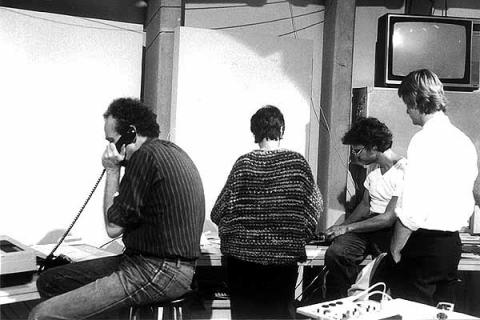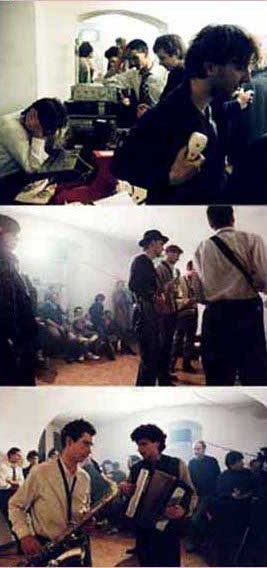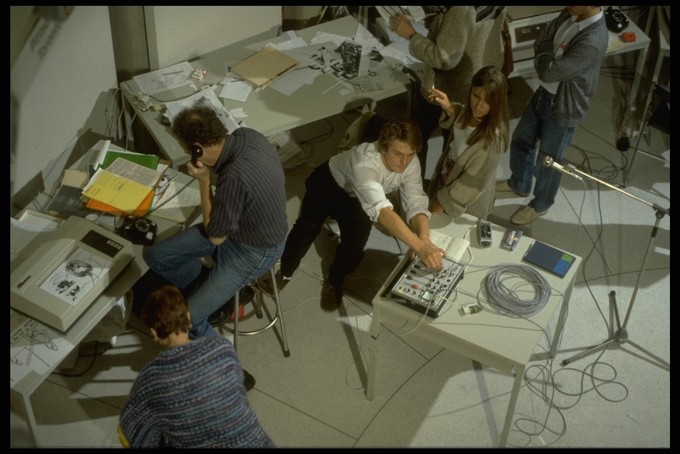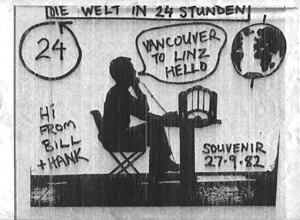Artist Robert Adrian (1935-2015, also known as Robert Adrian X), founder of what was likely the first artist-initiated online community, passed away in September. As 2015 comes to a close, Rhizome is republishing the following excerpt from Josephine Bosma's indispensable book Nettitudes: Let's Talk Net Art in which she recalls meeting Adrian at an event in 1993 and learning about net art for the first time. (For a more complete treatment of Adrian's career, see Armin Medosch's moving tribute, published in October on thenextlayer.org.)
It was the summer of 1993 and the internet was only slowly finding its way into the public consciousness. I was visiting V2_, the Institute for Unstable Media, because I was interviewing artists who worked with the body. The body was V2_'s focus for that year. Adrian was introduced to me as "the initiator of the first email network for artists," a network he had produced as early as 1980, and had served as the basis for the earliest net art projects between 1981 and 1983. I was introduced to a history of art in computer networks I had never heard of, and I could hardly believe that it had already been in existence for over ten years.

Robert Adrian (left) at The World in 24 Hours (1982)
Like so many others, I knew about cyberpunk, the new wave in science fiction made famous by William Gibson and Bruce Sterling, and had even read their books in the 1980s. The "cyberspace" they described, however, was (and is) largely fictional. Robert Adrian X described a history that was much different from the all-encompassing, seamless immersiveness of Gibson's Neuromancer universe. Adrian's was a virtual environment made up of clunky machines and very diverse social groupings that barely fit together, between which connections sputtered and soared unevenly, but through which dazzling and moving shapes unfolded. I had been looking for a kind of art that matched the irregularly dispersed but provocative media landscape of which I felt a part.
The vista that unfolded through the words and works of Robert Adrian X revealed an embodied contemporary and interdisciplinary practice that hit home. I decided right then and there to focus exclusively on art in the context of the Net. I wanted to learn how art, culture, and human nature would develop under these new circumstances.

Poster from The Art of Being Everywhere, held at V2_, Rotterdam, in 1993.
Bosma's conversation with Adrian, one of the first interviews she ever conducted, is published below. (A more thorough discussion of Adrian's work can be found in his 1997 interview with Tilman Baumgartel, published on the email list nettime.)
JB: What are you going to talk about this afternoon?
RAX: Basically about artists using communication technologies. There has been a lot of work done in the field over the last ten years, none of it very successful. Now we're looking at a new technology and hoping it will go better in the future.
JB: What is this new technology?
RAX: I suppose it is the old technology which has got much cheaper and much more sophisticated, and the telephone system has become more flexible and better. It means that there has also been a change in how people think to some degree about operating with each other over telephone lines. I think there has been a change in society which allows artists to work without putting themselves in the center: working with other artists, working with groups of artists, working with a public who is not really a public but collaborators if you like. People who come into a communications project are more likely to take part than they used to be.

The World in 24 Hours (1982)
JB: The audience has changed?
RAX: Audience is a difficult word because you get this concept structure with 'audience' of people sitting quietly and watching. But with communications projects by artists, or by anybody else for that matter, they are not interesting if you do not participate. So people tend to not sit and watch. They tend to either go away or try to join. A new kind of relationship is developing inside the society itself too.
JB: Would you call an artist in this context more an initiator?
RAX: That is one of the roles an artist can have in this new kind of environment, an electronic environment. It is pretty hard to find any specific place where artists fit. Lots of other people don't seem to have much place in this new kind of technology, but artists are perhaps among the few people who can find some ways to use these technologies without working for a large corporation and find some creative use for this kind technology. That may be one of our roles.
JB: Does this make art also less focused on itself, l'art pour l'art as they say?
RAX: It is very hard to identify anything what happens today as art in the traditional sense of the word. The technology gets to be about itself. Technology for technology's sake, which is the condition of much of the technology we're using. In the development phase it tends to be technology developed by technicians that are used to just talk about technology. Now we want to penetrate some of these systems and talk about other things, while using that technology. We find a lot of resistance among the technicians. For artists to work in such an environment there is no tradition. There is no art about art there. Our problem is to discover if art is possible at all, if there is any place for artists in these systems. If I didn't think there was I wouldn't be doing it, but if I am asked straight up I have problems saying where the art is.
JB: So you couldn't give me examples of how art inside the technology has links outside the technology?
RAX: I would not assume there was an inside or outside to technology. The way our culture has changed the last ten, twenty, maybe the last fifty years it is completely defined by technology. So anything an artist does with technology is central to the whole culture. There is no inside or outside any longer. There are none of these distinctions, which we are used to with industrial cultures.

The World in 24 Hours (1982). Photo: Sepp Schaffler
JB: Are you saying this art is more connected to society?
RAX: It is not easy to define those things in this environment, because we need to clarify what society is. Society has changed so much in the last decades that one has trouble using the same vocabulary as before. We lost a whole lot of vocabulary we brought from the arts and other disciplines to talk about society, about work, about social issues. The reality is that none of these words mean what they meant before. They don't mean anything. We can't talk about progress. Who believes in progress?
JB: How do you approach this problem?
RAX: Approach is good. I find myself in the middle of a problem, which is only now becoming clear, now we've come to see that something really serious has changed. As an artist one experiences that personally because if you are making sculptures or paintings: nobody cares about these things anymore. Only buyers and sellers care about them. They became products and very boring products mostly. So what do you do as an artist when you find that everything you like doing is more or less meaningless? Either you go on because you like doing it, which is like Winston Churchill doing his watercolors or Prince Charles, an amateur artist. You do it because you love it and you don't care if it is important or art. Or you quit and you try to find out what's happened to the culture that we can go on making something like the kind of art you've done in the past. I have worked in communications media parallel to working as an artist making sculptures for example. I did the same work in two different ways.
JB: You are an artist?
RAX: I am an artist. I am not anything else. I have nothing to do with technology. I don't like technology even. Gerfried [Stocker, now director of Ars Electronica, who is also at the event] is the technologist. But he is a musician. He does not like technology much either. He's a trained communications engineer who left his job and has been working as a musician. He makes robotic devices and large-scale sculptures and interactive environments. He comes to this kind of work out of the technology towards art, and I come out of art in the direction of technology as an artist. We work together on this particular project, but I also work with other people and so does he. Where ever I am needed or I need somebody I phone around until I find somebody who can do something for me, and I get calls from people who say they need this or that.
JB: I just interviewed another artist [David Blair] who said that what he feared most in the future of art and the new technologies was 'the loss of biological presence'. Can you imagine an artist has a problem with loosing something he can touch, physically?
RAX: That question really opens up a whole box of problems. The biological presence is something that you can't help but have. No matter how much you think you have none, your brain is operating biologically, it can't be helped. Flusser among others has talked about the silicon culture and the carbon culture, silicon culture being thinking machines or computers and electronic devices and carbon culture being vegetable, animal, biological culture. The distinction is, I think, not as clear as one thinks. The machines we've built, it is probably true that they are disembodied, they don't have bodies in the sense that we mean they are more or less pure thought or pure idea.

Fax received during The World in 24 Hours (1982). Photograph: Robert Adrian.
JB: But that is still a material, the machine. When an artist works in a network for instance the piece that occurs or the performance that occurs is only in the screen or only in cyberspace, right?
RAX: Well yeah. Cyberspace is really difficult. It is William Gibson writing novels. Cyberspace has become a very useful way to describe a space that may or may not be there. It does not stop you being a biological entity when you use technology. The thing that is missing from all of these works, whatever you call them, is some sort of product. In none of these is there some sort of tangible product. That is missing from the art using these technologies. The machines are on: the product is there. But it is not a product, because you turn it off and it is gone again. It is not the piece of tape, it is not the disc, it is not whatever storage mechanism you use. It is only reproduced whenever the machine is on. Then you get the whole chain reaction: it is only there when the power is switched on. The power is only on when the machines are running to make the electricity going through the wires. One comes to the question where this all lies because the machines control the power generation, that is their main role. Computer technology distributes electricity, so you already have now a sort of parallel power structure or infrastructure, which is none biological. But our position in this situation can be nothing but biological. What we have to get used to is an art which has no physical property, non-objective art. If art is going to be meaningful it has to be involved with these new technologies, but these technologies do not produce that kind of thing any longer. They are not mechanical or physical devices. These are devices that produce electronic data and this does not have any physical property.
JB: What is the network you are going to be talking about here?
RAX: This is a network for cultural exchange. It is meant to be universally available. It is supposed to be interactive and it is part of a network of private bulletin boards called Fido, the Fido net. There are about 500,000 users in the world of this network, but it is a real amateur net. It does not cost anything, just phone up into your local bulletin board and sign on. But it is not easy to use. Well, it is uncomfortable let's say. Sometimes the messages get lost, they come a long way. But on these boxes there are all kinds of information. You can put your own information. It is self-publishing. It is also messaging, sending messages to each other. It is also dealing with software. Its main purpose in the beginning was to talk about software among technologists. But now I have to stop because I have to prepare for my talk.
JB: Good luck. Thank you!
_large.jpeg)
ZEROnet (1992)


